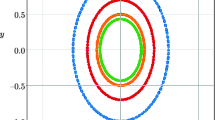Abstract
The main results are, firstly, a generalization of the Conley–Zehnder index from ODEs to the delay equation at hand and, secondly, the equality of the Morse index and the clockwise normalized Conley–Zehnder index \( \mu^{\rm CZ} \). We consider the nonlocal Lagrangian action functional \( {\mathcal{B}} \) discovered by Barutello, Ortega, and Verzini [7] with which they obtained a new regularization of the Kepler problem. Critical points of this functional are regularized periodic solutions \(x\) of the Kepler problem. In this article, we look at period 1 only and at dimension one (gravitational free fall). Via a nonlocal Legendre transform regularized periodic Kepler orbits \(x\) can be interpreted as periodic solutions \((x,y)\) of a Hamiltonian delay equation. In particular, regularized \(1\)-periodic solutions of the free fall are represented variationally in two ways: as critical points \(x\) of a nonlocal Lagrangian action functional and as critical points \((x,y)\) of a nonlocal Hamiltonian action functional. As critical points of the Lagrangian action, the \(1\)-periodic solutions have a finite Morse index which we compute first. As critical points of the Hamiltonian action \( {\mathcal{A}} _ {\mathcal{H}} \), one encounters the obstacle, due to nonlocality, that the \(1\)-periodic solutions are not generated any more by a flow on the phase space manifold. Hence, the usual definition of the Conley–Zehnder index as the intersection number with a Maslov cycle is not available. In the local case, Hofer, Wysocki, and Zehnder [10] gave an alternative definition of the Conley–Zehnder index by assigning a winding number to each eigenvalue of the Hessian of \( {\mathcal{A}} _ {\mathcal{H}} \) at critical points. In this article, we show how to generalize the Conley–Zehnder index to the nonlocal case at hand. On one side, we discover how properties from the local case generalize to this delay equation, and on the other side, we see a new phenomenon arising. In contrast to the local case, the winding number is no longer monotone as a function of the eigenvalues.






Similar content being viewed by others
Notes
Because the elements of the target \(L^2\) of \(L_S\) are not necessarily continuous, a requirement to close up after time \(1\) would be meaningless, hence, paths \(S:[0,1]\to \Bbb R^{2\times 2}\) are fine.
New phenomena appear in the case \(n=0\). For instance, the geometric multiplicities of \(\lambda_0^\mp\) are \(1\), as opposed to \(2\) in the case \(n>0\).
A real number is called transcendental
Lindemann showed that \(\pi\) is transcendental: there is no nonzero polynomial with rational coefficients having \(\pi\) as a zero.
References
P. Albers, U. Frauenfelder, and F. Schlenk, “A Compactness Result for Non-Local Unregularized Gradient Flow Lines”, J. Fixed Point Theory Appl., 21:1 (2019), 34–61.
P. Albers, U. Frauenfelder, and F. Schlenk, “An Iterated Graph Construction and Periodic Orbits of Hamiltonian Delay Equations”, J. Differential Equations, 266:5 (2019), 2466–2492.
P. Albers, U. Frauenfelder, and F. Schlenk, “Hamiltonian Delay Equations—Examples and a Lower Bound for the Number of Periodic Solutions”, Adv. Math., 373:107319:17 (2020).
V. I. Arnol'd, “On a Characteristic Class Entering into Conditions of Quantization”, Funktsional. Anal. i Prilozhen., 1 (1967), 1–14.
A. Abbondandolo and M. Schwarz, “On the Floer Homology of Cotangent Bundles”, Comm. Pure Appl. Math., 59:2 (2006), 254–316.
A. Abbondandolo and M. Schwarz, “The Role of the Legendre Transform in the Study of the Floer Complex of Cotangent Bundles”, Comm. Pure Appl. Math., 68:11 (2015), 1885–1945.
V. Barutello, R. Ortega, and G. Verzini, “Regularized Variational Principles for the Perturbed Kepler Problem”, Adv. Math., 383:107694, 64 (2021).
U. Frauenfelder and J. Weber, “The Shift Map on Floer Trajectory Spaces”, J. Symplectic Geom., 19:2 (2021), 351–397.
D. Hilbert, “Über die Transcendenz der Zahlen \(e\) und \(\pi\)”, Math. Ann., 43:2 (1893), 216–219.
H. Hofer, K. Wysocki, and E. Zehnder, “Properties of Pseudo-Holomorphic Curves in Symplectisations. II. Embedding Controls and Algebraic Invariants”, Geom. Funct. Anal., 5:2 (1995), 270–328.
T. Levi-Civita, “Sur la régularisation du problème des trois corps”, Acta Math., 42 (1920), 99–144.
F. Lindemann, “Ueber die Zahl \(\pi\)”, Math. Ann., 20:2 (1882), 213–225.
V. P. Maslov, Theory of Perturbations and Asymptotic Methods, izd. MGU, 1965.
J. Moser, “Regularization of Kepler’s Problem and the Averaging Method on a Manifold”, Comm. Pure Appl. Math., 23 (1970), 609–636.
D. Salamon and J. Weber, “Floer Homology and the Heat Flow”, Geom. Funct. Anal., 16:5 (2006), 1050–1138.
C. Viterbo, Functors and Computations in Floer Homology with Applications. II, Preprint Université Paris-Sud no. 98–15, 1998.
J. Weber, “Perturbed Closed Geodesics Are Periodic Orbits: Index and Transversality”, Math. Z., 241:1 (2002), 45–82.
J. Weber, Topological Methods in the Quest for Periodic Orbits, Publicaç\~oes Matemáticas do IMPA [IMPA Mathematical Publications]. Instituto Nacional de Matemática Pura e Aplicada (IMPA), Rio de Janeiro, 31\({^{\rm{o}}}\) Colóquio Brasileiro de Matemática. vii+248 pp. ISBN: 978-85-244-0439-9, 2017.
Funding
UF acknowledges support by the DFG grant FR 2637/2-2.
Author information
Authors and Affiliations
Corresponding authors
Rights and permissions
About this article
Cite this article
Frauenfelder, U., Weber, J. The Regularized Free Fall I. Index Computations. Russ. J. Math. Phys. 28, 464–487 (2021). https://doi.org/10.1134/S1061920821040063
Received:
Revised:
Accepted:
Published:
Issue Date:
DOI: https://doi.org/10.1134/S1061920821040063



